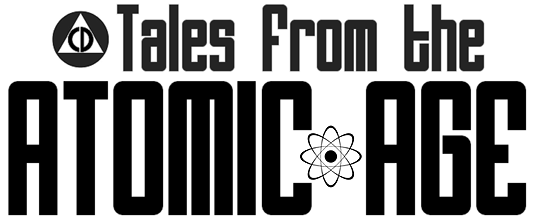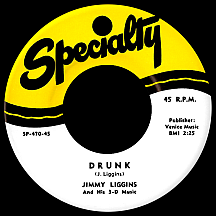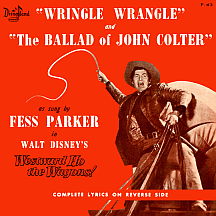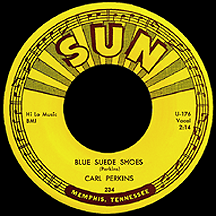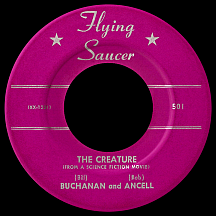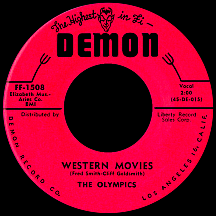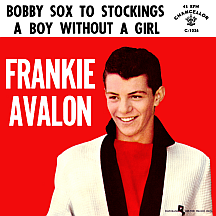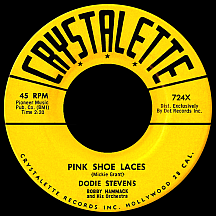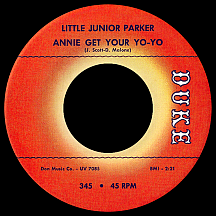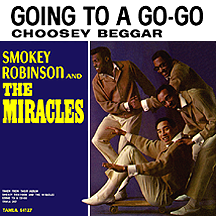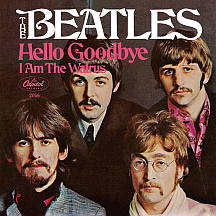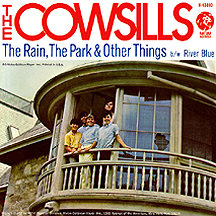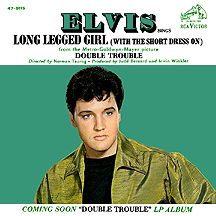Fly-By-Night Fun:
Fashion and Fads, Toys and Trends
A fad, by definition, is fleeting; the word can be used to identify popular trends that typically spend a short time in the spotlight. The toys, trinkets, clothing styles and whatever else serves as the "latest thing" linger in the memory but occasionally resurface, usually only for a brief nostalgic reminiscence. In some cases a trend doesn't completely disappear; some fondly-remembered fads tend to recycle themselves as part of a general fascination with what could be termed "retro-chic." Those who create music have often sought to exploit timely trends and some of their recordings show a certain durability. Here's a look back at a handful of memorable pop culture fads and the songs that resulted.
The 3-D craze in cinema appeared to be short-lived and many predicted an early demise when the gimmick debuted in late 1952. Presented with great fanfare, the reality of those awkward tinted, disposable glasses required for viewing soon grew tiring. Horror film House of Wax, starring Vincent Price, was released in the spring of '53 and is among the more infamous of three-dimensional movies, yet the effects do little to make the experience more frightening (in one scene a man plays with a paddleball that appears to bounce off the screen and into the audience...whoopeee!). Within a couple of years the thrill of 3-D had run its course, though studios never gave up on it and the process has been revived off-and-on, its most successful phase coming in recent years. Musically there wasn't much one could do with 3-D, as it requires a visual element, but there were those who tried: "Drunk" was an R&B hit in 1953 credited to Jimmy Liggins and his 3-D Music, the effect being a double-tracked lead vocal. Big Jay McNeely simply titled one of his hot sax instrumentals "3-D" and The Dominoes pointed out they '...don't need no glasses' to see "My Baby's 3-D."
Fashion trends have been reflected in music at nearly every turn. Bell bottom trousers had been worn by sailors for more than a hundred years; Teresa Brewer was obsessed with one such Navy man in her 1954 hit "Bell Bottom Blues." The pants caught on big in the late '60s and '70s when practically everyone wore them. The coonskin caps popular with the frontiersmen of roughly 150 years earlier made an unforeseen comeback with America's youth, as television shows and films relived the historical era in which the rugged attire of animal skin was far more a necessity than a fashion statement. Davy Crockett, a series of episodes featured on ABC's Disneyland series in 1955, featured Fess Parker wearing one and it became his trademark as millions of the critter-caps were sold to young fans of the TV series. "The Ballad of Davy Crockett" was a hit that year in versions by Bill Hayes, Tennessee Ernie Ford and Parker, who happily ditched the coonskin for films like Disney's Westward Ho the Wagons! Still, he had difficulty avoiding the dreaded head attire, as it was standard garb for his hit NBC series Daniel Boone, which ran from 1964 until 1970.
Suede shoes were most popular in shades of brown or gray...until Carl Perkins created a demand for the shoe in azure hues when his recording of "Blue Suede Shoes" became a major hit in the spring of 1956. A version by Elvis Presley shortly afterwards validated Carl's choice of footwear; those blue suedes have since become a classic icon of rock and roll's early years. While the flashy foot fashion represented youth culture, flat top haircuts were favored by many adult males, particularly authoritative fathers who usually had backgrounds in the military. You can probably lay blame on those dads for the increasing numbers of young boys wearing the clippered buzz cut in the 1950s; Dorothy Collins and Boyd Bennett praised the style with their hit versions of "My Boy - Flat Top." There was one upside to the super-short haircut: a comb was optional.
It wasn't easy to find a fun side to the flying saucer paranoia that caused a frenzy after the alleged landing of a whirling extraterrestrial disc in Roswell, New Mexico in 1947. Musicians had a good time with the idea anyway, as science fiction writers had for decades. The Mello-Tones harmonized about "Flying Saucers," gospel-style, in 1951. Others followed suit; Billy Riley and his Little Green Men discovered the aliens had musical talent in 1957, recounting the experience with "Flyin' Saucers Rock and Roll." Buchanan and Goodman went to the furthest extreme with several "break-in" novelty recordings (using snippets of hit songs for humorous purposes) beginning with "The Flying Saucer" in the summer of '56; within weeks of the single's release a plethora of imitations appeared including "Out of This World with Flying Saucers" by Dave Barry with Sara Berner, "The Answer To The Flying Saucer U.F.O. (Men From Mars)" by Syd Lawrence and Friends, "Marty on Planet Mars" by Marty and many, many others. Buchanan and Ancell had their own monster movie sendup, "The Creature (From a Science Fiction Movie)," and put it out on the all-too-obvious Flying Saucer record label.
The boomerang, a functional, curved hunk of wood, had been tossed around by overzealous Aussies for decades, or so the image has developed; Australian aborigines used it for hunting hundreds of years ago. By the '50s the throw-and-it'll-return device was being used in sports competitions and toy versions were selling like crazy. The De Castro Sisters applied it to romantic rebound in '55 with "Boom Boom Boomerang," British comedian Charlie Drake affected a down-under accent and stirred up trouble with the '62 hit "My Boomerang Won't Come Back" and Jr. Walker and the All Stars turned it into a dance in '65: "Do the Boomerang."
The Wham-O company hit pay dirt in 1958 when it marketed the hula hoop, not a particularly original idea, but the timing was right. Tens of millions of the hoops were sold, children and adults were twirling to their heart's delights, and all was right with the world for awhile. Georgia Gibbs and Teresa Brewer documented the 1958 sensation with separate versions of "The Hula Hoop Song," while Betty Johnson's "Hoopa Hoola" used slangier terms to describe the 'big round ring.' Betty also criticized roller rink mania in 1959, claiming "You Can't Get to Heaven on Roller Skates." Seven years later, Roger Miller pointed out the obvious: "You Can't Roller Skate in a Buffalo Herd."
TV saturated American households in the early '50s and stations around the country were in a bind to find cost-effective programming to fill their schedules. B flicks from the '30s and '40s with little or no remaining commercial potential (or so the film industry thought) were packaged in large lots and sold on the cheap; many of these films were westerns with no-name stars and interchangeable scripts...and viewers loved them. In 1958, The Olympics noted the effect a girlfriend's obsession with "Western Movies" could have on a person's love life. Film studios combatted the television craze with widescreen (CinemaScope, VistaVision) presentations and the expansion of drive-in movie theaters (an innovation of the 1930s) as thousands of giant outdoor screens spread across the American landscape, popular in the '50s and '60s for date nights and family excursions. Eddie Cochran sang about taking a first date to a "Drive In Show" in '57...and splitting six hot dogs with her!
What were people wearing? What were designers thinking? Dogs were influencing women's fashions! The poodle skirt was purely a '50s phenomenon; the poodle cut, curled up on top of the head, was also popular (Lucille Ball wore it and the weekly exposure on America's most-watched TV show, I Love Lucy, resulted in millions of women emulating her hairstyle). Clint Miller was one cat who dug the look: the poodle cut sported by "Bertha Lou" had a strange effect on Clint: '...you tickle me from head to my ath-a-lete-a-feet!' Pedal Pushers, women's pants worn at calf-length, were everywhere...with pointed toe shoes sometimes part of the look. Carl Perkins commented on the resurgence of both with "Pink Pedal Pushers" in '58 and "Pointed Toe Shoes" in '59.
Bobby socks, worn at the ankles and folded down, were common among schoolgirls; Frankie Avalon made a reference to the transition from childhood to adulthood in "Bobby Sox to Stockings." Meanwhile, men were wearing Oxford saddle shoes or white bucks, similar but different footwear. Bobby Pedrick, Jr. professed to wearing them both in his '58 hit "White Bucks and Saddle Shoes," also pointing out 'what the kids all choose': chinos and slacks, button-down shirts and crew neck sweaters. Then there were tan shoes, pink shoelaces, polka dot vests and big panamas with purple hat bands...pretty safe to say no one wore this improbable combination except "Dooley" of Dodie Stevens's 1959 hit "Pink Shoe Laces." In 1963, "Calling All Cars" had Russ Regan (going incognito as Davey Summers) searching for his ideal woman who had, unfortunately, slipped through his fingers: 'She was wearing saucy blue jeans and bobby sox...with big blue eyes and goldilocks...a bright red sweater hangin' down to her knees...' If you find this little girl...get in line behind those guys wrapped 'round the block!
Seems everyone under a certain age had a Yo-Yo in the 1960s, though the stringed toy had been around for centuries in one form or another. Successfully remarketed by the Duncan company, it found its way into pop culture in 1962 hits by Little Junior Parker ("Annie Get Your Yo-Yo") and Dr. Feelgood and the Interns ("Right String But the Wrong Yo-Yo," a remake of "The Wrong Yoyo" by Dr. Feelgood, recording in 1951 as Piano Red) as well as Billy Joe Royal's "Yo-Yo" in '66 (later a hit for The Osmonds). There was a simulative alternative to surfing for kids who were too young, or small, or geographically challenged, to participate in what was quite possibly America's favorite '60s pastime. The ever-popular skateboard, about two to two-and-a-half feet long, crossed the surfboard with roller skates. Jan and Dean's collection of surfing hits in '63 and '64 included one about the landlubber's surfboard, an invitation to enjoy the pavement sport called "Sidewalk Surfin'."
While dance trends are not covered here, the go-go dancers of the 1960s are etched in our minds as a visual icon of the decade (usually confined to a large version of a birdcage, the female gyrators typically wore miniskirts and brightly-colored "go-go boots"). Dobie Gray was a fan of the many nightclubs where the girls displayed their assets, saying "See You at the 'Go-Go'" in 1965, then The Miracles were "Going to a Go-Go" in '66 and Lee Dorsey went wild for a "Go-Go Girl" in '67. The boldest fashion yet debuted in 1964 by designer Rudi Gernreich; the topless bathing suit received headline coverage at the time, though its popularity was limited considering strictly-enforced decency laws in effect almost everywhere in America. The Rip Chords found a way around the suggestiveness of the "One Piece Topless Bathing Suit" by revealing in the song's final verse that the wearer was four years old.
The lava lamp was a distinctly '60s creation, its colorful globs of floating goo providing happy hours of hypnotic pleasure to mind-trippers who owned one; rock band Blues Magoos featured specially-made giant lava lamps at concert appearances in the late '60s. Folk and hippie fashions had begun to dominate; a few examples include Ben Franklin-style eyewear (also called "granny glasses," they were proudly worn by Roger McGuinn of The Byrds and John Lennon of The Beatles), hip-hugger pants (the term borrowed by Booker T. and the MG's for the 1967 instrumental hit "Hip Hug-Her") and the pillbox hats that became a trendy fashion when Jacqueline Kennedy wore them. Bob Dylan jokingly ridiculed the "Leopard-Skin Pill-Box Hat" ('...tell me, baby, how your head feels under somethin' like that') in his 1967 hit of the same title.
"Flower Power" followers were less specific about styles dictated by the fashion world, instead just taking a free-form approach that often involved bright, flowery colors. Women favored old-fashioned "grandma dresses" and men showed a preference for tie-dye shirts with random psychedelic designs. Songs that tied in to the late '60s movement were popular in the months surrounding 1967's "Summer of Love": "The Flower Children" by Marcia Strassman, "San Francisco (Be Sure to Wear Some Flowers in Your Hair)" by Scott McKenzie and "The Rain, the Park and Others Things" (a love song to a 'flower girl') by The Cowsills. The grandmotherly look didn't attact the attention of men like the much-less-fabric-required miniskirts, a preference of girl-watchers everywhere: Elvis had a thing for the "Long Legged Girl (With the Short Dress On)" and Wilson Pickett chased after "Mini-Skirt Minnie." The Bob Crewe Generation (of "Music to Watch Girls By" notoriety) found the short-skirt fad was happening in a faraway land and released an instrumental, "Miniskirts in Moscow," to honor it.


